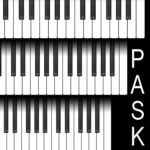Principles of ergonomics and biomechanics
Small-handed pianists are at a higher risk of injury due to greater wrist abduction, extension and deviation than larger-handed players.
Large chords, octaves and arpeggios repeatedly force small hands out of an ‘anatomically neutral’ relaxed position. Further, small hands are at a biomechanical disadvantage due to the need for increased hand movement in getting to the keys. These factors mean loss of power, speed, accuracy and tonal control, in addition to the greater risk of pain and injury.
Muscles and joints operating near the middle of their range rather than close to their limits will have a greater range of dynamic response. This means that those with large hands are more likely to be operating within the optimum range. On the other hand, those with small hands are more likely to be operating at the extremes and therefore less efficiently,
Highly respected piano teacher and performer, Linda Gould, suggests this simple experiment for pianists to help them understand the problems when hand spans are not well-matched ergonomically to a piano keyboard: https://www.narrowkeys.com/post/the-unknown-piano-technique-issue
Having to stretch further imposes increased muscular tension in those with smaller hands. More strength and effort is required, often leading to forearm fatigue during and after playing. This extra physical effort and fatigue results in increased mental effort to keep playing, as well as a progressive loss of power and control. Ability to focus on musicality is thus compromised. The impact of muscle fatigue on piano performance, including factors such as speed, accuracy and sound intensity, has been demonstrated in a recent Canadian study (Goubalt et al, 2021).
The aging process also has a degenerative effect on hand function, so young pianists who cope well with the conventional keyboard may encounter increasing difficulty with age. Many older pianists report that narrower keys increases their comfort and extends their playing life for many years. See: Impacts of aging
‘The three factors of hand width, finger length and finger abduction, …., will explain a surprisingly large number of technical difficulties that are often wrongly attributed to defects of coordination or studentship‘. (Otto Ortmann, 1929)
‘Fine dynamic gradation with the fingers in extreme stretches is physiologically impossible‘. (Otto Ortmann, 1929i
Ergonomics and biomechanics - evidence from the literature
Ergonomics and biomechanics provide evidence of the disadvantages of a hand that is not well matched to a piano keyboard. These relatively new disciplines can be used to determine the most efficient use of the human body in relation to piano technique. The basis of ergonomics is that ‘form follows function’, i.e. the design of tools and appliances need to be in accordance with the dimensions of the human hand. Biomechanical and ergonomic studies have determined that degree, repetitiveness and forcefulness of wrist motions are risk factors in tendinitis, carpal tunnel and other nerve entrapments. Female pianists, with their smaller hands and more delicate bone structure, are more susceptible to these ailments than males.
Wristen (2000) reviewed established quantitative data from biomechanical studies to describe and analyse the execution of selected piano tasks. She identified several motions and practice habits that have the potential to contribute to injury. These include wrist angle (radial and ulnar deviation, extreme pronation or supination) and repetitive motions of high force. Deahl & Wristen (2003) noted that small-handed pianists are at higher risk due to greater degrees of lateral wrist motion, flexion, extension and deviation that are required than for larger-handed players. Large chords, octaves and arpeggios repeatedly force small hands out of an ‘anatomic neutral’ position. This is consistent with the conclusions of Sakai’s (1992, 2002) clinical studies where he identified the playing of octaves and chords as likely causes of pain and injury.
Chong (2021) highlights increased fatigue affecting small-handed pianists. Fatigue occurs sooner when hands have to be positioned in awkward postures, which are defined as a deviation from a neutral position, such as in long passages of loud octaves.
Boyle (2013), in a presentation to the APPCA Piano Pedagogy Conference in July 2013, presented an analysis of the benefits of reduced size keyboards for smaller-handed pianists from a biomechanical and physiological perspective. This paper reviewed the pioneering work of Otto Ortmann (1929) early last century, which is based on sound scientific principles. Ortmann clearly recognized the significance of hand span in being able to play at the highest level, not just in terms of avoiding pain and injury, but achieving performance excellence. For example: ‘The three factors of hand width, finger length and finger abduction, to which, of course, the similar thumb values must be added, will explain a surprisingly large number of technical difficulties that are often wrongly attributed to defects of coordination or studentship’, and ‘Fine dynamic gradation with the fingers in extreme stretches is physiologically impossible’.
Biomechanical disadvantage also leads to increased muscular strain and mental effort, limiting a pianist’s ability to focus on musical expression. Renowned German scientist, the late Christoph Wagner (1984) hinted at this: ‘Perhaps the most important effect of biomechanical disadvantage lies in the increased load on the central nervous system’.
Chi et al (2020) conducted a systematic review of ergonomic factors in violin and piano playing. While they found that smaller hand size is correlated with increased PRMD incidence among pianists, they concluded that inconsistent methodological quality and measuring tools or protocols hindered the ability to pool data and form robust conclusions. See also Epidemiological and clinical studies
Refer also to the page on Performance quality.
References
Boyle, R. (2013). The benefits of reduced-size keyboards for smaller-handed pianists: An exploration of biomechanical and physiological factors. Proceedings of the 11th Australasian Piano Pedagogy Conference: Opening Doors: The Complete Musician in a Digital Age. University of Southern Queensland, Toowoomba, 2-6 July 2013. https://appca.com.au/proceedings/proceedings.html Copy here: https://paskpiano.org/wp-content/uploads/2021/10/R-Boyle-APPCA-conference-paper_July-2013.pdf
Chi, Ju-Yang, Halaki, M. & Ackermann B.J. (2020). Ergonomics in violin and piano playing: A systematic review. Applied Ergonomics, 88, 1031-43.
Chong, T. (2021). Pianism for small hands: Strategies and solutions to optimize performance and minimize chances of injury. DMA thesis submitted to Indiana University Jacobs School of Music. https://scholarworks.iu.edu/dspace/bitstream/handle/2022/26412/Chong%2C%20Tina%20%28DM%20Piano%29.pdf?sequence=1&isAllowed=y
Deahl, L. & Wristen, B. (2003). Strategies for small-handed pianists. American Music Teacher, 52 (6), 21-25.
Goubalt, E,, Verdugo, F., Pelletier, J., Traube, C., Begon, M. & Maso, F. (2021). Exhausting repetitive piano tasks lead to local forearm manifestation of muscular fatigue and negatively affect musical parameters. Nature Briefing. https://www.nature.com/articles/s41598-021-87403-8
Grieco, A. Occhipinti, E., Colombini, D., Menoni, O., Bulgheroni, M. Frigo, C. & Boccardi, S. (1989). Muscular effort and musculoskeletal disorders in piano students: electromyographic, clinical and preventive aspects. Ergonomics, 32 (7),697-716.
Kochevitsky, G. (1967). The Art of Piano Playing. Summy-Birchard Music Inc., USA.
Meinke, W.B. (1995). The work of piano virtuosity: An ergonomic analysis. Medical Problems of Performing Artists, 10 (2), 48-61.
Neuhaus, H. (1973). The Art of Piano Playing, Barrie & Jenkins, London.
Ortmann, O. (1929). The Physiological Mechanics of Piano Technique. Kegan Paul, Trench, Trubner & Co., London, and E.P. Dutton & Co., Inc., New York.
Prenger, M. (2013). Hand en piano. Handreikingen voor de lespraktijk. EPTA Nederland. https://eptanederland.nl/piano-bulletin/90-2013-3/
Turner, C., Visentin, P. & Shan, Gongbing. (2021). Wrist internal loading and tempo-dependent, effort-reducing motor behaviour strategies for two elite pianists. Medical Problems of Performing Artists, 36 (3), 141-149.
Wagner, C.H. (1984). Success and failure in musical performance: Biomechanics of the hand. In Roehmann F.L., & Wilson F.R. (Eds): The Biology of Music Making, Proceedings of the 1984 Denver Conference, St Louis, Missouri, MMB Music Inc., 1988, 154-179.
Wagner, C.H. (2012). Musicians’ hand problems: looking at individuality. Medical Problems of Performing Artists, 27, (2), 57-64.
Wristen, B. (2000). Avoiding piano-related injury: a proposed theoretical procedure for biomechanical analysis of piano technique. Medical Problems of Performing Artists, 15 (2), 55-64.
Wristen, B. & Deahl, L. (2002). Small hands SOS! Circumventing injury and succeeding at the piano. Music Teachers’ National Association, Cincinnati, Ohio. http://digitalcommons.unl.edu/musicpresentations/1/


